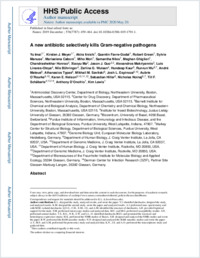A new antibiotic selectively kills Gram-negative pathogens.
- Imai Y Antimicrobial Discovery Center, Department of Biology, Northeastern University, Boston, MA, USA.
- Meyer KJ Antimicrobial Discovery Center, Department of Biology, Northeastern University, Boston, MA, USA.
- Iinishi A Antimicrobial Discovery Center, Department of Biology, Northeastern University, Boston, MA, USA.
- Favre-Godal Q Antimicrobial Discovery Center, Department of Biology, Northeastern University, Boston, MA, USA.
- Green R Antimicrobial Discovery Center, Department of Biology, Northeastern University, Boston, MA, USA.
- Manuse S Antimicrobial Discovery Center, Department of Biology, Northeastern University, Boston, MA, USA.
- Caboni M Antimicrobial Discovery Center, Department of Biology, Northeastern University, Boston, MA, USA.
- Mori M Antimicrobial Discovery Center, Department of Biology, Northeastern University, Boston, MA, USA.
- Niles S Antimicrobial Discovery Center, Department of Biology, Northeastern University, Boston, MA, USA.
- Ghiglieri M Antimicrobial Discovery Center, Department of Biology, Northeastern University, Boston, MA, USA.
- Honrao C Center for Drug Discovery, Department of Pharmaceutical Sciences, Northeastern University, Boston, MA, USA.
- Ma X Center for Drug Discovery, Department of Pharmaceutical Sciences, Northeastern University, Boston, MA, USA.
- Guo JJ Center for Drug Discovery, Department of Pharmaceutical Sciences, Northeastern University, Boston, MA, USA.
- Makriyannis A Center for Drug Discovery, Department of Pharmaceutical Sciences, Northeastern University, Boston, MA, USA.
- Linares-Otoya L Institute for Insect Biotechnology, Justus-Liebig-University of Giessen, Giessen, Germany.
- Böhringer N Institute for Insect Biotechnology, Justus-Liebig-University of Giessen, Giessen, Germany.
- Wuisan ZG Institute for Insect Biotechnology, Justus-Liebig-University of Giessen, Giessen, Germany.
- Kaur H Biozentrum, University of Basel, Basel, Switzerland.
- Wu R Purdue Institute of Inflammation, Immunology and Infectious Disease, Purdue University, West Lafayette, IN, USA.
- Mateus A Genome Biology Unit, European Molecular Biology Laboratory, Heidelberg, Germany.
- Typas A Genome Biology Unit, European Molecular Biology Laboratory, Heidelberg, Germany.
- Savitski MM Genome Biology Unit, European Molecular Biology Laboratory, Heidelberg, Germany.
- Espinoza JL Department of Human Biology, J. Craig Venter Institute, La Jolla, CA, USA.
- O'Rourke A Department of Human Biology, J. Craig Venter Institute, La Jolla, CA, USA.
- Nelson KE Department of Human Biology, J. Craig Venter Institute, La Jolla, CA, USA.
- Hiller S Biozentrum, University of Basel, Basel, Switzerland.
- Noinaj N Purdue Institute of Inflammation, Immunology and Infectious Disease, Purdue University, West Lafayette, IN, USA.
- Schäberle TF Institute for Insect Biotechnology, Justus-Liebig-University of Giessen, Giessen, Germany.
- D'Onofrio A Antimicrobial Discovery Center, Department of Biology, Northeastern University, Boston, MA, USA.
- Lewis K Antimicrobial Discovery Center, Department of Biology, Northeastern University, Boston, MA, USA. k.lewis@neu.edu.
- 2019-11-21
Published in:
- Nature. - 2019
Animals
Anti-Bacterial Agents
Bacterial Outer Membrane Proteins
Cell Line
Disease Models, Animal
Drug Discovery
Drug Resistance, Microbial
Escherichia coli Proteins
Female
Gastrointestinal Microbiome
Gram-Negative Bacteria
Humans
Mice
Microbial Sensitivity Tests
Microbial Viability
Mutation
Nematoda
Operon
Photorhabdus
Substrate Specificity
Symbiosis
English
The current need for novel antibiotics is especially acute for drug-resistant Gram-negative pathogens1,2. These microorganisms have a highly restrictive permeability barrier, which limits the penetration of most compounds3,4. As a result, the last class of antibiotics that acted against Gram-negative bacteria was developed in the 1960s2. We reason that useful compounds can be found in bacteria that share similar requirements for antibiotics with humans, and focus on Photorhabdus symbionts of entomopathogenic nematode microbiomes. Here we report a new antibiotic that we name darobactin, which was obtained using a screen of Photorhabdus isolates. Darobactin is coded by a silent operon with little production under laboratory conditions, and is ribosomally synthesized. Darobactin has an unusual structure with two fused rings that form post-translationally. The compound is active against important Gram-negative pathogens both in vitro and in animal models of infection. Mutants that are resistant to darobactin map to BamA, an essential chaperone and translocator that folds outer membrane proteins. Our study suggests that bacterial symbionts of animals contain antibiotics that are particularly suitable for development into therapeutics.
- Language
-
- English
- Open access status
- green
- Identifiers
-
- DOI 10.1038/s41586-019-1791-1
- PMID 31747680
- Persistent URL
- https://folia.unifr.ch/global/documents/180022
Statistics
Document views: 31
File downloads:
- fulltext.pdf: 0
